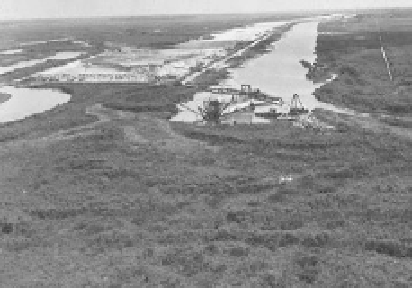Environmental Engineering Reference
In-Depth Information
Dec15,2003
MississippiRiver
sedimentͲladenwater
DavisPondDiversionStructure
Davis Pond diversion structure
outflowchannel
DavisPondarea
Fig. 8.80
Davis pond diversion structure in December 2003, two weeks after a full-capacity test-run. (Source:
http://visibleearth.nasa.gov)
(waterfowl, migratory birds, and fish). The wetlands associated with the floodplain historically supported
a diverse waterbird assemblage that included 17 species of wading birds and 19 species of waterfowl.
However, as a result of intensive river training during 1962-1970, the Kissimmee River was channelized
and transformed into a series of impounded reservoirs (Toth, 1993). Figure 8.81 compares the original
Kissimmee River and channelized Kissimmee River. As a result, much of the adjoining floodplain was
drained and many associated wetlands gradually disappeared, which severely impacted the Kissimmee's
ecosystem, especially fish and other wildlife. For example, in the early 1970s wintering waterfowl
populations decreased by 92%; lower dissolved oxygen levels led to the loss of largemouth bass; the
stable water levels largely eliminated the fish spawning and foraging habitat (Perrin et al., 1982).
Fig. 8.81
Original Kissimmee River (left) and channelized Kissimmee River (right) (Hovey, 2000)
During the 1970s and 1980s, environmental concerns increased in the Kissimmee Basin. In 1991, the
Kissimmee River Restoration Project was authorized by the U.S. Congress, with a total cost of $578


























Search WWH ::

Custom Search